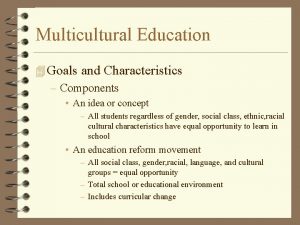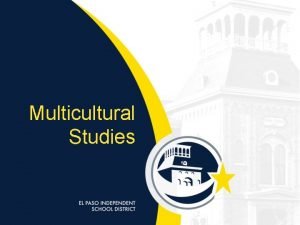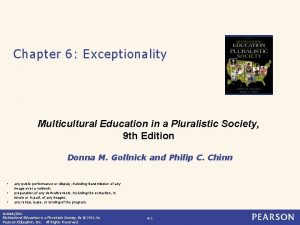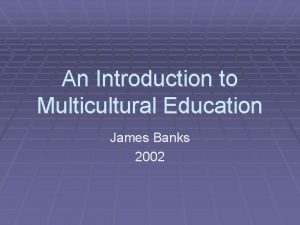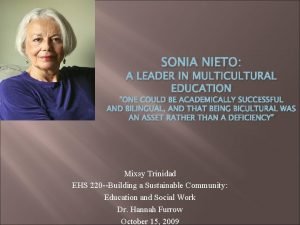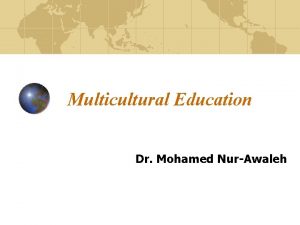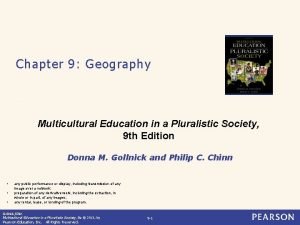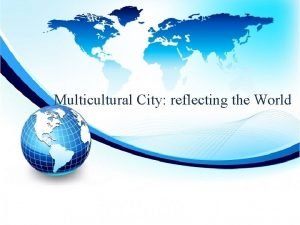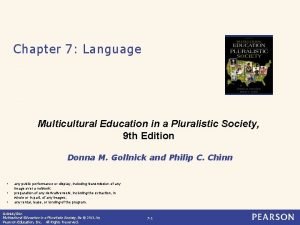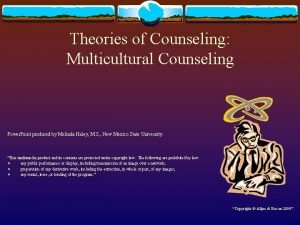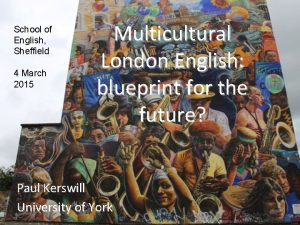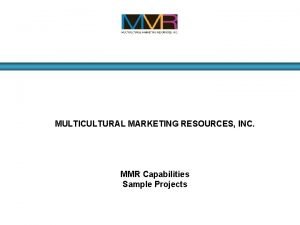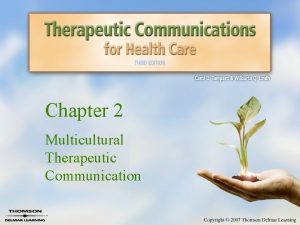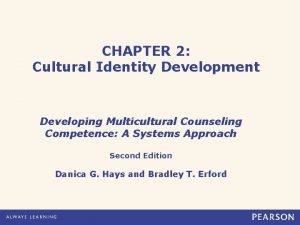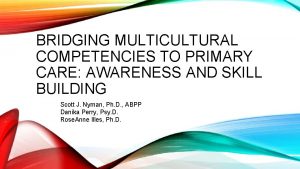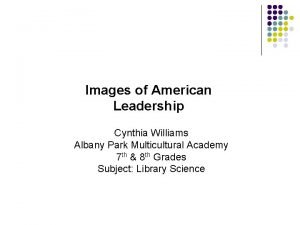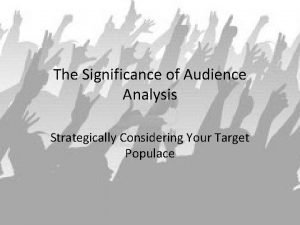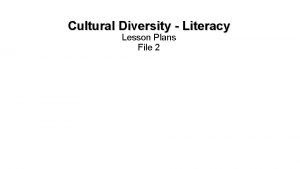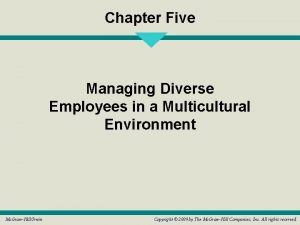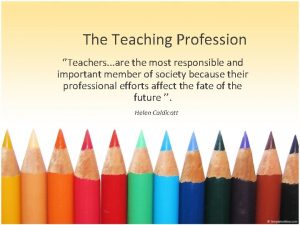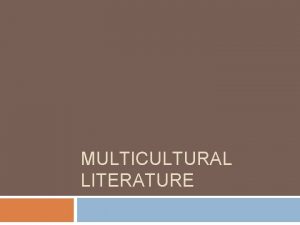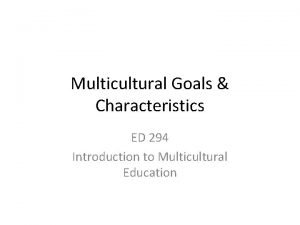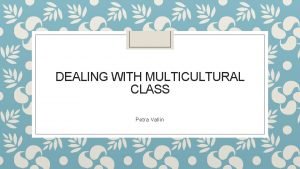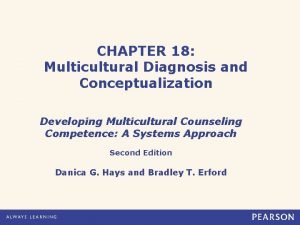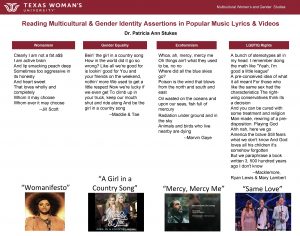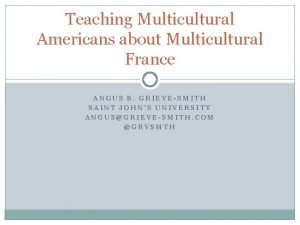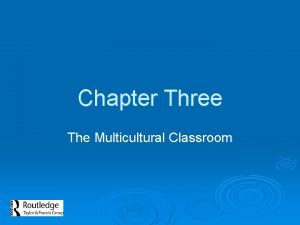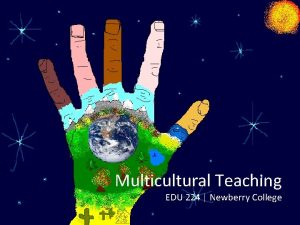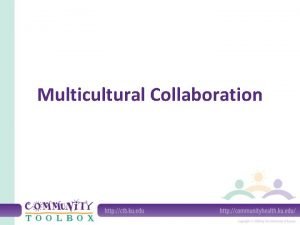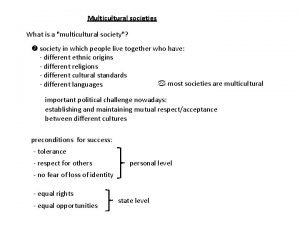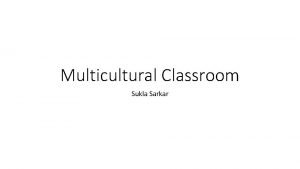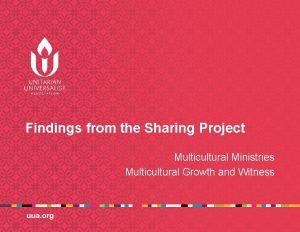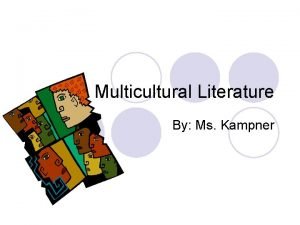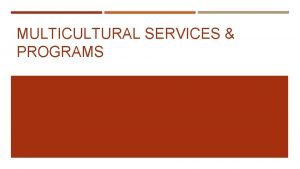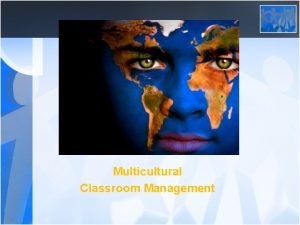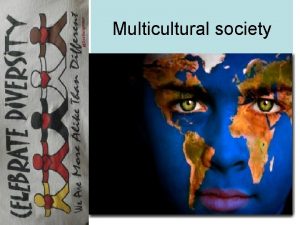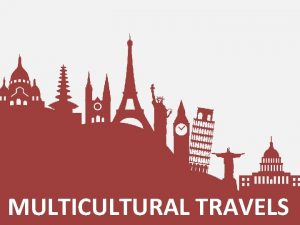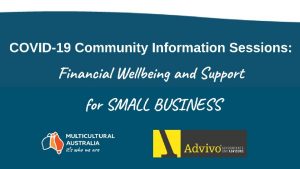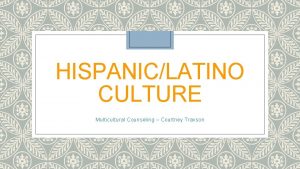Multicultural Education 4 Goals and Characteristics Components An





























- Slides: 29

Multicultural Education 4 Goals and Characteristics – Components • An idea or concept – All students regardless of gender, social class, ethnic, racial cultural characteristics have equal opportunity to learn in school • An education reform movement – All social class, gender, racial, language, and cultural groups = equal opportunity – Total school or educational environment – Includes curricular change

4 A process – Continuous change 4 Major goals – Improve academic achievement – Promote strength and value of culture – Promote human rights, respect for those different, social justice, equal opportunity, and distribution of power among groups

4 Promote alternative life choices for people

Dimensions of multicultural education 4 Content integration 4 The knowledge construction process 4 Prejudice reduction 4 An equity pedagogy 4 An empowering school culture and social structure

History of Development 4 Civil rights movement of 1960 s 4 Goal – To eliminate discrimination in public accommodations, housing, employment, and education 4 Results – Significant influence on institutions of education (reform curricular, hiring practices, community control of school in

– neighborhoods, textbook revision – Celebrate holidays, other special days, ethnic celebrations – Single group studies – Other marginalized groups take action in 1970 s • grievances and demands more human rights • senior citizens, disable, etc. • mainstreaming in education – Women (employment, income, education, child rearing)

The 1980 s 4 Support somewhat diminished – Governmental policies conservative – Critics became active – Present • Profess they understand , but know little about it • Policy mandates require the inclusion of content • Household term in media

James Banks’ phases of multicultural education 4 Phase I – Monoethnic studies • • Civil rights movement Demand of African American teachers More community control of schools Text revision and contributions 4 Phase II – Multiethnic studies • Focus on several minority groups • Comparative perspective

4 Phase III – Multiethnic studies education • Realization that reforming courses was insufficient to result in genuine educational reform 4 Phase IV – Multicultural education • Interest in broader development of pluralistic education • Want reform of total school environment • Focus on a wider range of racial and ethnic groups

4 Phase V – Slowly occurring process designed to increase pace and scope of the institutionalization of multiethnic multicultural education within school

Five Characteristics Culture 4 Culture is learned. 4 A culture is logically integrated, functional, sense-making whole. 4 All cultures are constantly changing; no culture is completely static. 4 Every culture has a “value system”. 4 Culture make possible the reasonably efficient, largely automatic interaction

– between individuals that is a prerequisite to social life.

Understanding Culture 4 National – American, Japanese, Mexican, etc. 4 Ethnic – African American, Hispanic American, Native American, Asian American, European American, etc. 4 Regional – (U. S. , West Coast, East Coast etc. )

4 Gender – Male & Female 4 Socioeconomic Class – Rich & Poor 4 Age – Different generations 4 Socioeconomic Class – Rich & Poor

4 Physical Ability – Disabled, hearing impaired, blind, wheelchair, etc. 4 Sexual Orientation – Beliefs and values that may accompany being gay, lesbian, bisexual, or heterosexual 4 Corporate – Utilities, Computers, Insurance, etc.

4 Departmental – Accounting, Field operations, etc. 4 Union – Skill and professional associations

Society, Culture, the Individual 4 Society – An organized group of individuals. Each society possesses a culture, a set of customs and traditions that designate appropriate or required ways of acting, thinking and feeling. 4 Culture – An organized group of learned responses characteristics of a particular society. Social heritage and design for living shared by group of people and transmitted to the following

– generations. 4 The Individual – A living organism capable of independent thought, feeling, and action, but with independence limited and all responses profoundly modified by contact with the society and culture in which one develops. 4 Social Structure or Organization – A complex system of interrelated positions and their accompanying roles that define the

– behavior of individuals and their relations with one another. 4 Position – refers to location within a society. Every person occupies several different positions simultaneously. In each position certain things are expected of him/her to fulfill certain roles 4 Role – Refers to the pattern of behavior that is

– expected or required of a person who occupies a particular position. An individual’s role in connection with each position he/she occupies consists of things he /she is expected to do, other things he/she may or may not do as he/she sees fit, and still other things that he/she is expected not to do. Knowing the cultural norm means we can predict the consequences of certain behavior.

Individual 4 Gender 4 Perception & 4 Race/nationality expectations in life 4 Hemispericity &/or learning style 4 Ethnic background 4 SES 4 Geographic region 4 Personal interest 4 Lifestyle of family 4 Abilities/disabilities – Left/right brained 4 Values – Upbringing – Life experiences

The Components of the North America Culture: Values and Beliefs 4 Rugged Individualism: – Individual primary unit – Has primary responsibility – Independence and autonomy highly values and rewarded – Individual can control environment 4 Competition: – Winning is everything – Win/lose dichotomy 4 Action Oriented: – Must master and control nature – Must always do something about a situation – Pragmatic/utilitarian view of lie

4 Decision Making: – Majority rule when whites have power – Hierarchical – Pyramid structure 4 Holidays: – Based on Christian religion, White history, male leaders 4 Communication: – Standard English 4 Time: – Written tradition – Adherence to rigid time schedule – Direct eye contact – Time viewed as a – Limited physical commodity contact – Controlled emotions

4 Religion: – Belief in Christianity – No tolerance for deviation from single god concept 4 History: – Based on European immigrants experience in the U. S. – Romanticize war 4 Protestant Work Ethic: – Working hard brings success 4 Progress and Future Orientation: – Plan for future – Delayed gratification – Value continual improvement and progress

4 Emphasis on Scientific method: – Objective, rational, linear thinking – Cause and effect relationships – Quantitative emphasis – Dualistic thinking 4 Status and Power: – Measured by economic – – possessions Credentials, titles, and positions Believe “own” system Believe better than other systems Owning goods, space, standard property

4 Family Structure – Nuclear family is the ideal social unit – Man is bread winner and head – Woman is homemaker and subordinate to husband – Patriarchal structure 4 Aesthetics: – Music and art based on European culture – Women’s beauty based on blonde, blue-eyed, thin, young – Men’s attractiveness based on athletic ability, power, economic status

Why Important 4 Enhances a good self-concept and self understanding 4 Sensitivity to and understanding of others, including cultural groups around world 4 Ability to perceive and understand multiple and sometimes conflicting, cultural and national interpretations of and perspectives on events, values, and behavior

4 Ability to make decisions and take effective action based on multicultural analysis and synthesis 4 Open minds when addressing issues 4 Understand the process of stereotyping, a low degree of stereotypical thinking, and pride inself and respect for all peoples

School a Social System 4 The hidden curriculum • Attitudes • Text p. 24
 Multicultural classroom characteristics
Multicultural classroom characteristics Goals of multicultural education
Goals of multicultural education Strategic goals tactical goals operational goals
Strategic goals tactical goals operational goals Strategic goals tactical goals operational goals
Strategic goals tactical goals operational goals Multicultural education in a pluralistic society
Multicultural education in a pluralistic society James banks multicultural education five dimensions
James banks multicultural education five dimensions Nieto euskaraz
Nieto euskaraz Misconceptions of multicultural education
Misconceptions of multicultural education Multicultural education in a pluralistic society chapter 1
Multicultural education in a pluralistic society chapter 1 Multiculturalism negative effects
Multiculturalism negative effects Rent multicultural education in a pluralistic society
Rent multicultural education in a pluralistic society General goals and specific goals
General goals and specific goals Motivation in consumer behaviour
Motivation in consumer behaviour Multicultural society pros and cons
Multicultural society pros and cons Five levels of consciousness
Five levels of consciousness Multicultural london english
Multicultural london english Lisa skriloff
Lisa skriloff Interviewing in action in a multicultural world
Interviewing in action in a multicultural world Multicultural view of existentialism
Multicultural view of existentialism Multicultural therapeutic communication skills
Multicultural therapeutic communication skills Multicultural counseling definition
Multicultural counseling definition Multicultural primary care
Multicultural primary care Albany park multicultural academy
Albany park multicultural academy Situational audience analysis example
Situational audience analysis example Courtland c lee
Courtland c lee Multicultural lesson plan example
Multicultural lesson plan example Managing diverse employees in a multicultural environment
Managing diverse employees in a multicultural environment Republic act 4670 reflection
Republic act 4670 reflection Multicultural literature definition
Multicultural literature definition Multicultural health definition
Multicultural health definition
